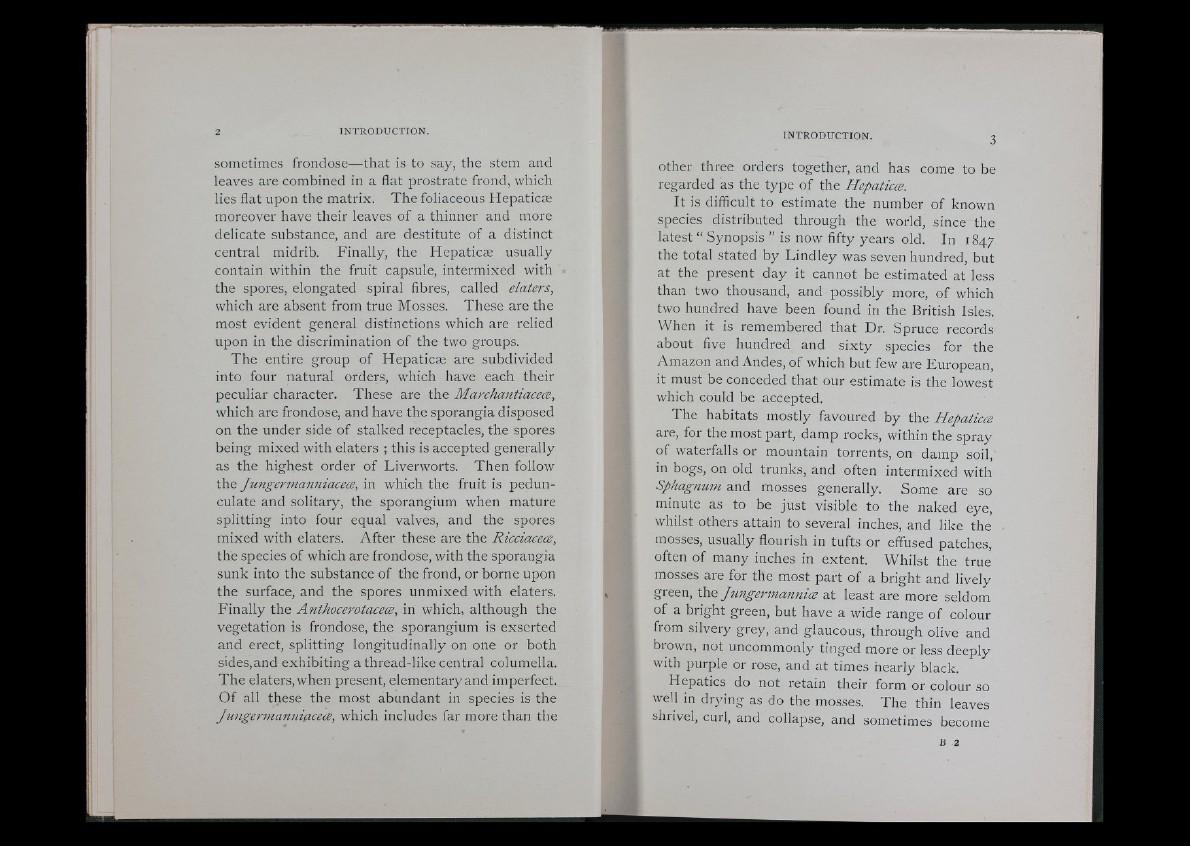
sometimes frondose— that is to say, the stem and
leaves are combined in a flat prostrate frond, which
lies flat upon the matrix. The foliaceous Hepaticae
moreover have their leaves of a thinner and more
delicate substance, and are destitute of a distinct
central midrib. Finally, the Hepaticae usually
contain within the fruit capsule, intermixed with
the spores, elongated spiral fibres, called elaters,
which are absent from true Mosses. These are the
most evident general distinctions which are relied
upon in the discrimination of the two groups.
The entire group of Hepaticae are subdivided
into four natural orders, which have each their
peculiar character. These are the Marchantiacece,
which are frondose, and have the sporangia disposed
on the under side of stalked receptacles, the spores
being mixed with elaters ; this is accepted generally
as the highest order of Liverworts. Then follow
the JungcrmanniacecE, in which the fruit is pedunculate
and solitary, the sporangium when mature
splitting into four equal valves, and the spores
mixed with elaters. After these are the Ricciacecs,
the species of which are frondose, with the sporangia
sunk into the substance of the frond, or borne upon
the surface, and the spores unmixed with elaters.
Finally the Anthocerotacece., in which, although the
vegetation is frondose, the sporangium is exserted
and erect, splitting longitudinally on one or both
sides,and exhibiting a thread-like central columella.
The elaters, when present, elementary and imperfect.
Of all these the most abundant in species is the
Jungermanniacece, which includes far more than tlie
other three orders together, and has come to be
regarded as the type of the Hepaticcs.
It is difficult to estimate the number of known
species distributed through the world, since the
latest “ Synopsis ” is now fifty years old. In 1847
the total stated by Lindley was seven hundred, but
at the pre.sent day it cannot be estimated at less
than two thousand, and possibly more, of which
two hundred have been found in the British Isles.
When it is remembered that Dr. Spruce records
about five hundred and sixty species for the
Amazon and Andes, o f which but few are Luropean,
it must be conceded that our estimate is the lowest
which could be accepted.
The habitats mostly favoured by the Hepaticcz
are, for the most part, damp rocks, within the spray
of waterfalls or mountain torrents, on damp soil,
in bogs, on old trunks, and often intermixed with
Sphagnum and mosses generally. Some are so
minute as to be just visible to the naked eye,
whilst others attain to several inches, and like the
mosses, usually flourish in tufts or effused patches,
often of many inches in extent. Whilst the true
mosses are for the most part of a bright and lively
green, the Jungermaiinioi at least are more seldom
of a bright green, but have a wide range of colour
from silvery grey, and glaucous, through olive and
brown, not uncommonly tinged more or less deeply
with purple or rose, and at times nearly black.
Hepatics do not retain their form or colour so
well in drying as do the mosses. The thin leaves
shrivel, curl, and collapse, and sometimes become